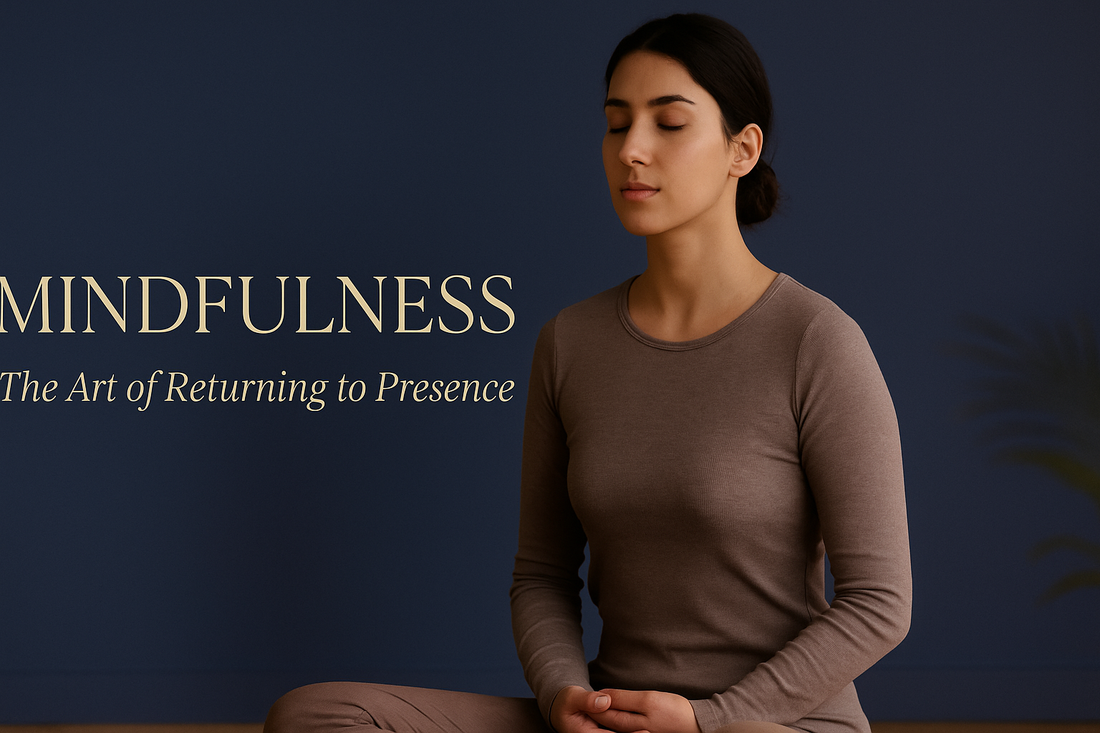
Mindfulness: The Art of Returning to Presence
Share
In an age of constant motion, stillness has become a form of strength.
Mindfulness is the practice of returning to that stillness — of meeting each moment with awareness, rather than distraction. It is not a trend or technique, but a way of seeing. Through mindfulness, we begin to move with intention, to breathe with awareness, and to live with greater balance.
What Is Mindfulness?
At its essence, mindfulness is the awareness of the present moment.
It is observing thoughts, emotions, and sensations as they arise — without judgment and without trying to change them.
This awareness helps create a sense of spaciousness in the mind, allowing calm and clarity to take root naturally.
Mindfulness is not about control; it’s about connection.
Connection to breath, body, and the quiet rhythm beneath daily life.
Simple Mindfulness Practices for Everyday Life
You don’t need a special setting to begin.
Mindfulness can live in simple, ordinary moments — morning light, the warmth of a cup, the sound of your breath. Here are a few gentle ways to bring it into your day:
1. The Three-Breath Pause
Before opening your phone, answering a message, or entering a meeting — pause.
Take three slow, intentional breaths. Feel the rise and fall of the chest.
Notice how stillness feels when you give it room.
2. Mindful Walking
Choose a short path and walk slowly.
Notice the ground beneath your feet, the air against your skin, the sounds around you.
If thoughts arise, allow them to pass through like clouds in a wide sky.
3. Body Awareness Meditation
Find a quiet place to sit or lie down.
Bring your attention to different parts of the body — from the crown of the head to the soles of the feet.
Notice sensations without judgment. This gentle awareness helps bring you back into the body — the true home of presence.
4. The Gratitude Reflection
At the end of each day, close your eyes and recall three moments that brought a sense of peace.
They can be small — a kind word, a soft breeze, a pause between tasks.
Noticing them nurtures mindfulness and a deeper sense of contentment.
Different Meditation Styles That Support Mindfulness
Mindfulness can be cultivated through various forms of meditation. Each approach offers a different doorway into awareness, yet all lead to the same inner stillness. Below are a few practices you can explore to find what resonates most naturally with you.
1. Breath-Focused Meditation
This is one of the most accessible forms of meditation.
Begin by sitting comfortably with your spine upright and shoulders relaxed.
Close your eyes and bring attention to your natural breath — the rhythm, the temperature, the gentle rise and fall.
When your mind begins to wander, softly return to the breath without judgment.
Over time, this practice helps anchor the mind, creating space between thought and awareness.
2. Guided Visualization
In guided visualization, a teacher or recording leads you through a peaceful journey — perhaps a walk through a forest, a quiet beach, or light radiating through the body.
This practice uses imagery to settle the mind and cultivate relaxation.
Visualization can be especially helpful for those who find it difficult to sit in silence, offering a gentle structure for presence to unfold.
3. Loving-Kindness Meditation (Metta)
This form of meditation centers around compassion — for oneself and for others.
Begin by repeating simple, heartfelt phrases such as:
“May I be calm. May I be at ease.”
Then extend the same phrases outward:
“May others be calm. May they be at ease.”
This meditation nurtures emotional openness and helps soften inner resistance, allowing a sense of connection and warmth to arise naturally.
4. Open Awareness Meditation
Also called “choiceless awareness,” this practice involves resting in observation.
Rather than focusing on one object, you allow all sensations, thoughts, and sounds to come and go freely.
You become the witness — aware of experience without clinging to it.
This meditation invites deep stillness and balance, offering a spacious understanding of the mind’s flow.
5. Mantra or Sound Meditation
In this practice, a word, phrase, or sound is repeated silently or aloud to center attention.
The repetition becomes a rhythm that quiets mental chatter and supports deeper focus.
You might choose a neutral sound like Om or a meaningful phrase that reflects calm and balance.
Mantra meditation can be particularly grounding when practiced with intention and consistency.
A Path Toward Calm
Mindfulness is a lifelong practice — not something to master, but to experience moment by moment.
As we learn to be still in thought and gentle in action, calm begins to unfold naturally.
Through this awareness, we reconnect with our essence — balanced, grounded, and whole.
At Ambrodha, we believe calm is not found; it’s remembered.
Mindfulness is how we return to it.